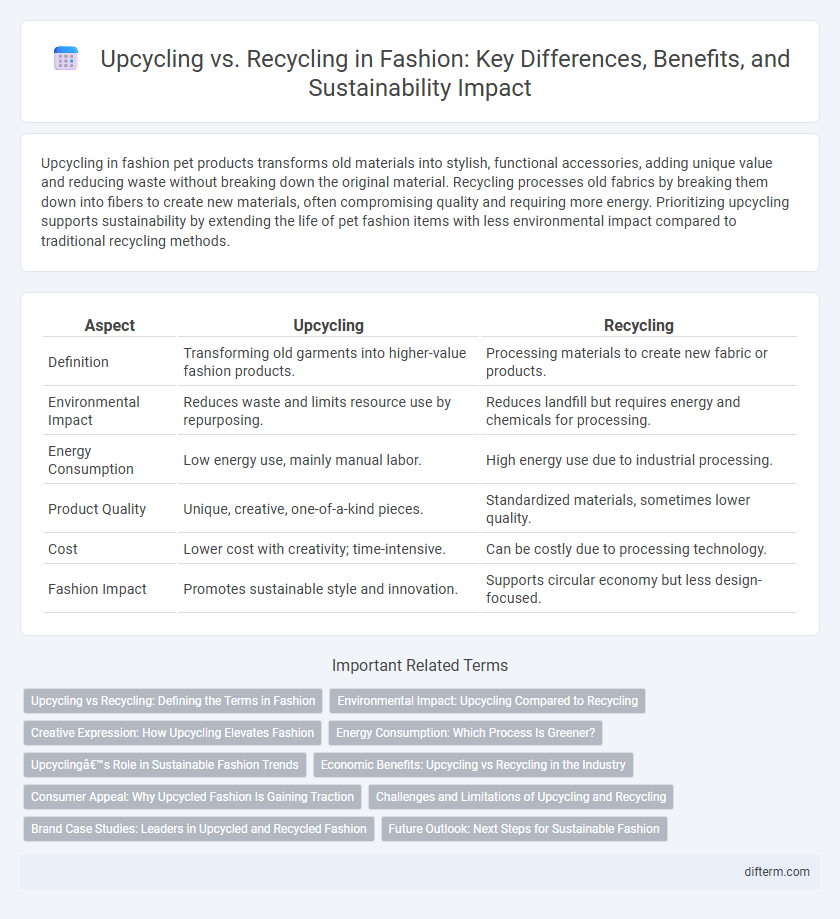Upcycling in fashion pet products transforms old materials into stylish, functional accessories, adding unique value and reducing waste without breaking down the original material. Recycling processes old fabrics by breaking them down into fibers to create new materials, often compromising quality and requiring more energy. Prioritizing upcycling supports sustainability by extending the life of pet fashion items with less environmental impact compared to traditional recycling methods.
Table of Comparison
| Aspect | Upcycling | Recycling |
|---|---|---|
| Definition | Transforming old garments into higher-value fashion products. | Processing materials to create new fabric or products. |
| Environmental Impact | Reduces waste and limits resource use by repurposing. | Reduces landfill but requires energy and chemicals for processing. |
| Energy Consumption | Low energy use, mainly manual labor. | High energy use due to industrial processing. |
| Product Quality | Unique, creative, one-of-a-kind pieces. | Standardized materials, sometimes lower quality. |
| Cost | Lower cost with creativity; time-intensive. | Can be costly due to processing technology. |
| Fashion Impact | Promotes sustainable style and innovation. | Supports circular economy but less design-focused. |
Upcycling vs Recycling: Defining the Terms in Fashion
Upcycling in fashion involves creatively transforming old or discarded garments into new, higher-value pieces, preserving fabric quality and design originality. Recycling entails breaking down textiles into raw materials to produce new fibers, often resulting in reduced fabric integrity and lower-quality products. Emphasizing upcycling supports sustainability by minimizing waste while maintaining garment uniqueness and extending product lifecycle.
Environmental Impact: Upcycling Compared to Recycling
Upcycling in fashion reduces textile waste by transforming old garments into new, high-quality products without breaking down fibers, which conserves energy and decreases carbon emissions more effectively than traditional recycling methods. Recycling often involves mechanical or chemical processes that degrade fabric quality and require significant water and chemical use, contributing to environmental pollution. Upcycling supports circular fashion by extending product life cycles and minimizing landfill contributions, making it a more sustainable solution for reducing the industry's ecological footprint.
Creative Expression: How Upcycling Elevates Fashion
Upcycling transforms discarded fashion materials into unique, high-quality pieces that highlight creativity and individuality, fostering a distinct artistic expression often lost in traditional recycling. The process encourages designers to experiment with textures, colors, and shapes, resulting in innovative garments that tell a story beyond mass-production. Embracing upcycling not only reduces waste but also elevates fashion into a personalized, sustainable art form.
Energy Consumption: Which Process Is Greener?
Upcycling in fashion significantly reduces energy consumption by repurposing existing materials without extensive processing or remanufacturing, unlike recycling which often requires energy-intensive breakdown and re-spinning of fabrics. Research indicates that recycling textiles can consume up to 50% more energy compared to upcycling due to the mechanical and chemical processes involved. Brands adopting upcycling practices contribute to lower carbon footprints and more sustainable production cycles, making it a greener choice in terms of energy efficiency.
Upcycling’s Role in Sustainable Fashion Trends
Upcycling in sustainable fashion transforms discarded materials into higher-value products, reducing waste and minimizing environmental impact compared to traditional recycling methods. This process promotes creativity and craftsmanship, resulting in unique, eco-conscious garments that align with the slow fashion movement. Emphasizing upcycling reinforces brand identity and appeals to consumers seeking ethical and innovative alternatives in the fashion industry.
Economic Benefits: Upcycling vs Recycling in the Industry
Upcycling generates higher economic value by transforming low-cost materials into unique, high-demand fashion pieces, enhancing brand differentiation and consumer appeal. Recycling often incurs lower profit margins due to the downgraded quality of fibers and higher processing costs, limiting its financial impact within the fashion industry. Upcycled products command premium pricing, drive sustainable consumer trends, and foster innovation, contributing to stronger revenue growth compared to traditional recycling methods.
Consumer Appeal: Why Upcycled Fashion Is Gaining Traction
Upcycled fashion captivates consumers by offering unique, one-of-a-kind pieces that emphasize creativity and sustainability, distinguishing itself from mass-produced recycled garments. The appeal of upcycled clothing lies in its storytelling and artisanal value, which resonate with eco-conscious shoppers seeking personalized style and environmental impact reduction. Brands prioritizing upcycling foster stronger customer loyalty by promoting authenticity and reducing textile waste through innovative design.
Challenges and Limitations of Upcycling and Recycling
Upcycling in fashion faces challenges such as inconsistent material quality and scalability issues, limiting mass production capabilities. Recycling apparel often encounters difficulties with fiber contamination and the degradation of fabric integrity, reducing the quality of recycled textiles. Both processes require significant resource investment in sorting and processing, which can hinder widespread adoption in the industry.
Brand Case Studies: Leaders in Upcycled and Recycled Fashion
Stella McCartney exemplifies leadership in sustainable fashion by integrating recycled materials into luxury collections, reducing environmental impact through innovative fabric sourcing and closed-loop systems. Patagonia's commitment to upcycling involves transforming post-consumer garments into high-performance outdoor apparel, setting industry standards for circular fashion and waste reduction. Eileen Fisher advances circularity with its Renew program, repairing and reselling used garments to extend product life and promote conscious consumerism.
Future Outlook: Next Steps for Sustainable Fashion
Upcycling transforms discarded materials into higher-value fashion items, reducing textile waste more effectively than traditional recycling, which often downgrades fiber quality. The future of sustainable fashion hinges on integrating technologically advanced upcycling processes with circular design principles to minimize environmental impact. Brands embracing transparent supply chains and innovative materials development will lead next-generation eco-conscious fashion trends.
upcycling vs recycling Infographic

 difterm.com
difterm.com